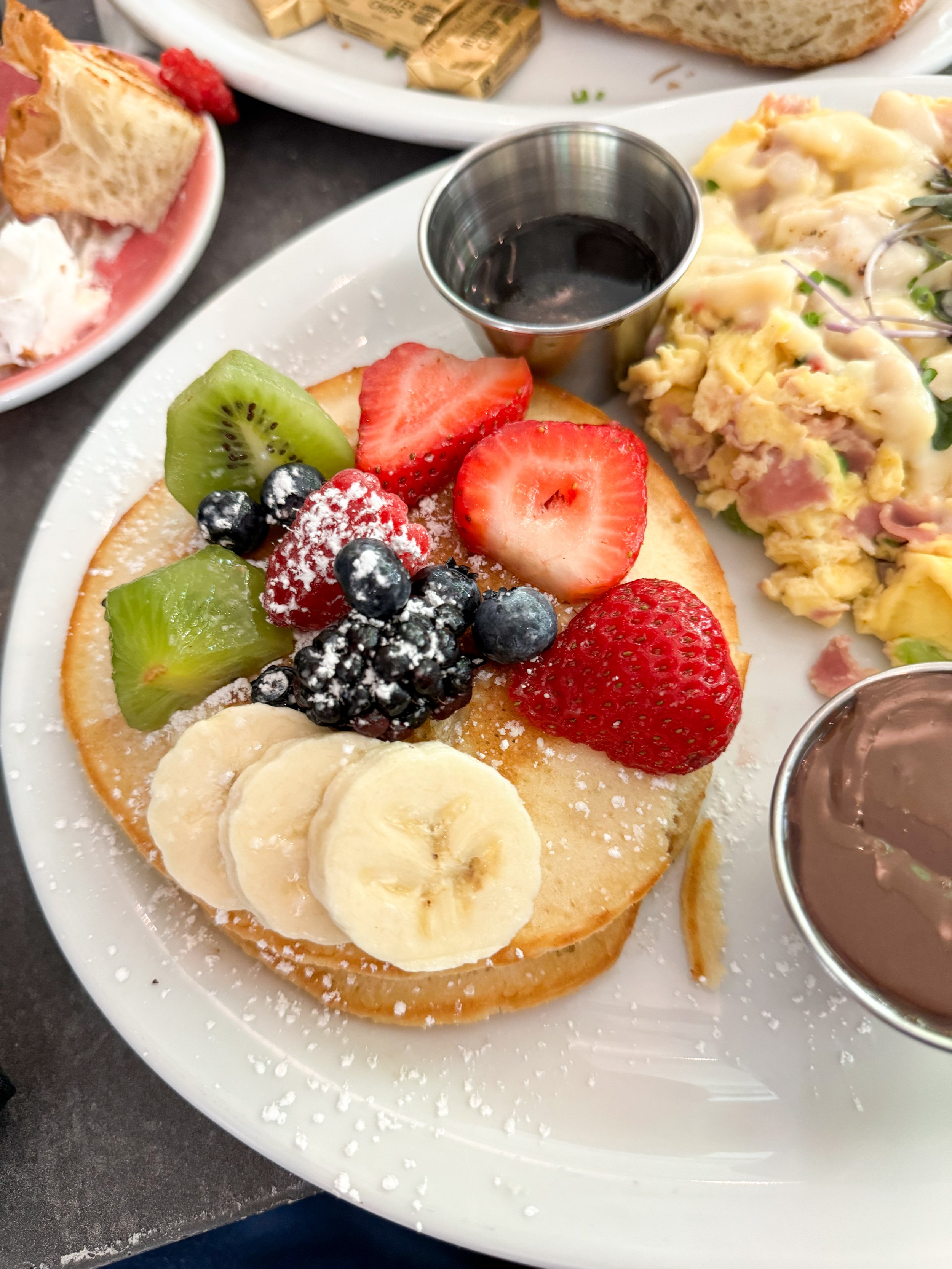8 Tips for Better Food Instagram Photos with Your Phone
Breakfast in Miami
Capturing mouth-watering food photos for Instagram doesn't have to be complicated. You also don’t have to have the most impressive camera or camera lens. With a few easy tricks, anyone can elevate their food photography using just their phone and go from taking just food pictures to telling a story through your images. The key to better food Instagram photos is to use natural light whenever possible. Avoid using the phone flash, as it can make the food look unappetizing and flat. When natural light is not available, try using an LED selfie light instead.
Angles matter too. Overhead shots can beautifully capture the entire table setup, while 45-degree angles work well for featuring multiple dishes and close ups. I prefer taking 45-degree angle pictures because to me it looks better and makes the food look extra scrumptious. Keeping your phone's camera lens clean ensures that every image is sharp and free from smudges.
You can also add things to your background and subject of photography. Adding a pop of color or a pattern can make your photos stand out. Think of your plate as a canvas and use it to frame the food creatively. Whether it's a vibrant tablecloth or colorful garnishes, these small touches can make a big difference. For more tips, check out these easy tricks shared by food influencers.
Products in this story are independently curated. If you make a purchase or booking through one of our links we may earn a small commission (don’t worry, it’s at no extra cost to you).
Setting the Stage
Choosing Your Background
A good background can make your food photos pop. A clean, uncluttered background is often the best choice. It keeps the focus on the food itself rather than distracting elements.
A simple wooden table, a marble countertop, or even a piece of neutral-colored fabric can serve as excellent backgrounds. These surfaces are non-distracting and can complement a variety of dishes. Patterns and colors can also add interest but should be used sparingly. For instance, adding a colorful napkin or placing the dish on a vibrant plate can enhance the visual appeal without overwhelming the main subject.
It is easier to have control over backgrounds when taking pictures of food at home, but it is also possible at restaurants. You can request to use things they have around for props and ask for a table near a nice wall that can bring a little extra to your pictures.
Natural Lighting and Time of Day
Natural light is a photographer's best friend. It’s free and can highlight the true colors and textures of the food. Position your setup near a window to make the most of the natural light available, don’t be afraid to ask for a table next to a window at a restaurant!
Avoid direct sunlight, which can create harsh shadows. Instead, aim for soft, diffused light. Mid-morning or late afternoon is often ideal, as the light is softer and more flattering during these times.
If you’re shooting in a room with limited natural light, use a white curtain to diffuse the light. This helps to soften shadows and create a pleasing, even illumination across your dish.
Composing the Shot
In food photography, how you compose the shot can make a big difference. This involves placing your subject correctly, choosing the right angles, and using the rule of thirds effectively.
Arranging Your Subject
Placement: Start by placing the main dish in the center of the frame. This makes it the focal point. Add accessories like forks, napkins, or side dishes around it to enhance the composition.
Texture and Color: Use different textures and colors to make the picture more interesting. Mix items like a smooth sauce with crunchy bread.
Background: Choose a simple background that contrasts with the food. This helps the dish stand out. Avoid busy patterns that can distract from the main subject.
Distance: Take a few steps back or use a wide-angle lens to capture a broader scene. This adds context and can make the photo feel more engaging.
Understanding Angles and Perspectives
Top-Down: Shooting from above is great for flat dishes like pizzas or salads. This angle captures all the details of the food and layout.
45-Degree Angle: This is a versatile angle that works well for most foods. It shows depth and dimension, making the food look more three-dimensional.
Side View: Side shots are good for tall or layered foods like burgers or cakes. This angle highlights the height and layers, making the photo more interesting.
Experiment: Don’t be afraid to move around. Try different angles to see which one works best for the dish you are photographing.
The Rule of Thirds in Composition
Grid: Use the grid function on your phone to mark your photo with two horizontal and two vertical lines, dividing it into nine parts. Place key elements along these lines or at their intersections to create a balanced photo.
Balance: This technique helps in creating balanced and engaging images. It guides the viewer's eye naturally through the composition.
Focus Points: Position the main subject off-center for a more dynamic photo. This can make the image more interesting and visually appealing.
Using the rule of thirds takes practice but can greatly improve the aesthetics of your food photos. By thinking about how you arrange your subject, consider different angles, and apply the rule of thirds, you'll be able to take more compelling food photos with your phone.
Technical Tips
Using Your Phone’s Features
Modern smartphones come packed with features to help capture stunning photos. Ensure to use grid lines to balance your shots. The rule of thirds, enabled by grid lines, can create more engaging compositions. Using the grid lines also makes it so much easier to keep your picture straight.
Experiment with your phone's camera modes. Portrait and Pro modes can provide greater control over depth and lighting. Portrait mode, for instance, can blur backgrounds, making the food stand out.
Clean the camera lens to avoid blurry images. Regularly wiping the lens can make a noticeable difference in clarity. If you take anything from this article, clean your lens, you will better your pictures by 60% already by just doing that simple task. I clean my lens every single time I am about to take a picture or a video.
Focus and Exposure Adjustments
Adjusting focus and exposure manually can drastically improve photo quality. Tap the screen to set the focus on the main subject. Phones often let you adjust exposure by sliding your finger up or down after focusing.
Use HDR (High Dynamic Range) mode to balance shadows and highlights. HDR can enhance details in both dark and bright areas, making the photo look more balanced.
Take multiple shots with different exposure levels. This can give you options and ensure you capture the best lighting.
Editing Apps to Enhance Your Photos
After taking your photos, use editing apps to make final adjustments. Popular apps like VSCO, Snapseed, and Lightroom offer a range of tools to enhance colors, sharpness, and overall appearance. They all have free options to use their apps, so don’t get scared about not being able to pay, you can use most of the functions you need for free.
Use filters sparingly to maintain a natural look. Adjust brightness, contrast, and saturation to bring out the food’s best features without overdoing it. Make sure that you are not over-saturating images.
Try cropping to improve composition. Removing unnecessary parts of the image can keep the focus on the food, making the picture more visually appealing.
Capturing the Moment
Conveying a Story
Food photos should tell a story, this is what will make you standout from any other creator. Think about what the dish represents. Is it a family recipe or a trendy café snack? Show elements that add context, like a rustic table for homemade meals or a chic backdrop for modern dishes.
Include utensils, napkins, or ingredients in the frame. They can hint at how the food is prepared or enjoyed. Steam rising from a cup of soup or a hand reaching for a cookie adds life to the image.
Timing is important. Freshly plated food looks its best. Capture moments like pouring syrup over pancakes or cutting into a juicy steak to showcase the texture and appeal.
Emphasizing Colors and Textures
Colors and textures make food photos pop. Bright, vibrant colors catch the eye. Use natural light to make colors stand out. Move items around to create balance. Think of the plate as a canvas.
Contrast is key. Pair dark shades with bright vegetables or fruits. Highlight different textures—crispy, creamy, and smooth elements add interest. Details matter—focus on the sprinkle of herbs or the shine of glaze on a cake.
Elements like a colorful napkin or a patterned plate can enhance the overall look. Keep backgrounds simple to avoid distractions. Experiment with angles and distances to capture the dish from its best perspective.
What is something you do to elevate your phone photography game?
Check my passion for food and storytelling over @LoveSWFL



